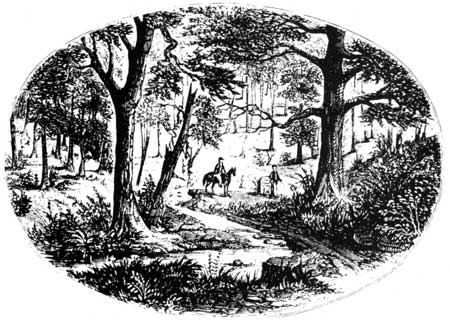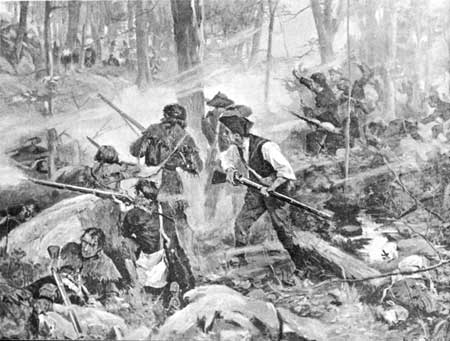|
KINGS MOUNTAIN National Military Park |
 |

The Kings Mountain Battleground, showing the north slope of the
ridge, on the left, and the original Chronicle marker in the background.
Sketched by Benson J. Lossing during his visit to the area on January 8, 1849.
The Pursuit to Kings Mountain
The American patriot force meanwhile had moved cautiously south ward down Cane Creek toward Gilbert Town on October 3. The following day, they learned that Ferguson had withdrawn from the town. At the time, he was miles away, camping at Tate's plantation. Although the mountain men were disappointed that they could not engage Ferguson at Gilbert Town, they did not permit this to dampen their hopes. They now took up a relentless pursuit of his retreating army.
By the evening of October 4 they had pushed farther southward and camped near Denard's Ford on the Broad River. At this point they temporarily lost Ferguson's trail. Continuing southward, however, on October 5 they completed a march of 12 miles and rested that night at Alexander's Ford on the Green River. On October 6 they pressed forward another 21 miles to reach the Cowpens. This point in South Carolina was so named because of the extensive Cattle enclosures owned there by Hiram Saunders, a wealthy Tory. Ferguson's hope that the mountain men would be misled and continue southward toward Ninety-Six was a false one. From the Cowpens, the route of the frontier army was to be generally southeastward toward the Broad River and then north and east to Kings Mountain.
Along their route to the Cowpens, the mountain men were favored by good fortune. They received accurate information from patriot supporters in the region regarding the country through which Ferguson's corps had passed in its retreat toward Kings Mountain and Charlotte. Their spirits were also spurred by Col. Edward Lacey, of South Carolina, who visited the patriot camp on the Green River to report that a large body of North and South Carolina militia was ready to join the expedition at the Cowpens.
As early as September 23, Col. James Williams, of South Carolina, with the permission of North Carolina patriot authorities, had issued a call for patriot recruits from the border of both States. His appeal was headed: "A call to arms: Beef, bread, and potatoes," and resulted in the assembling of 400 men. Included were the forces under local militia leaders, such as William Hill, Edward Lacey, James Hawthorne, Frederick Hambright, William Chronicle, and William Graham. When on the afternoon of October 6, these forces were united with Colonel Campbell's command at the Cowpens, the combined volunteer army numbered approximately 1,790 men.
At the Cowpens the report of a patriot spy named Joseph Kerr that Ferguson was only a few miles ahead in the vicinity of Kings Mountain, confirmed earlier rumors of the British force's position. To over take Ferguson without delay, the leaders of the patriot expedition chose from their various commands a select group of stalwart fighting men, all mounted, who immediately rode ahead during the night of October 6 towards Kings Mountain. The exact strength of this advance party is not known, but it is certain to have exceeded 900 men.
By this time, Ferguson's army was already encamped upon the top of King's Mountain. From Tate's plantation, his route on October 6 for 16 miles followed the old Cherokee Ferry Road between Buffalo and Kings Creek. He crossed a branch of Kings Creek near Whisnant's mill site and continued along the old Ridge Road to the main branch of Kings Creek. Fording this creek, Ferguson bore off in a northeastward direction toward what is known today as Hambright's Gap. Later in the day, he led his force through this gap toward the vital ridge of Kings Mountain, about three-quarters of a mile beyond.
The decision to post his army on the top of this ridge represented a change of his plan to push forward and join Cornwallis at Charlotte. It was a decision hard to understand when it is realized how close he was to the security of the main British army. It is generally believed, however, that Ferguson made the decision deliberately and with the definite intention of meeting the patriots in battle. That he felt secure in this position is shown from his letter of October 6 to Cornwallis, which stated: "I arrived to day at Kings Mountain & have taken a post where I do not think I can be forced by a stronger enemy than that against us." Ferguson was also known to be a vain man. Operating with the largest independent command of his military career, it is probable that he could not resist the temptation to seek for himself the glory of still another victory.
Meanwhile, the picked group of mountain men rode through the night toward their objective under the cover of a drizzling rain. To keep the flint locks of their weapons dry, bags, blankets, or even hunting shirts were wrapped around them. To add to their difficulties, a number of Campbell's men lost their way in the darkness. By the morning of October 7 they were rounded up and the progress of the march was delayed very little.

"The Battle of Kings Mountain."
From a painting by F. C.
Yohn.
The Americans approached the scene of the battle with great caution. Their path was along the same route as that followed by Ferguson on the preceding day. They passed near his campsite at Tate's plantation where they expected to find a covering force on the east bank of the Broad River. To avoid possible discovery at this point, they crossed the river at Cherokee Ford, 2-1/2 miles below. By the forenoon of October 7 the men and their horses showed the effects of the tiring overland march from the Cowpens. Despite the suggestion by a number of the leaders that a halt be called, Colonel Shelby is reported to have replied: "I will not stop until night, if I follow Ferguson into Cornwallis' lines."
It was not long before the patriots learned definitely that Ferguson was but a few miles ahead, posted on Kings Mountain. Constantly on the alert for Tories who could be expected to warn him of their approach, they followed the Ridge Road past present-day Antioch Church. From this point they proceeded in a northerly direction to an old colonial road leading from North Carolina to what is now York S. C. This road, which ran in a southeastward direction, led them over Ponder's Branch and a tributary of Kings Creek to Hambright's Gap, not far from the site of the coming battle.
Kings Mountain ridge, upon which the encounter soon occurred extends 600 yards in a northeasterly direction and forms but a small part of the 16-mile Kings Mountain range. The summit of the ridge, which was stony, stood about 6o feet above the surrounding country and was 60 to 120 feet wide. One of its main disadvantages was that the tree line stood almost to its top. This enabled an expert rifleman to fire effectively from ample cover on either side of the ridge upon individuals on its crest.
About a mile from the ridge the patriot leaders called a halt, the horses were hitched, and final battle instructions given the men. They were formed into 2 lines, each consisting of 2 columns, and were ordered to proceed on foot. Each detachment was to take a preas signed position at the base of the ridge to complete the encirclement of Ferguson's corps. The right flank column was composed of detachments under Major Winston, Colonel Sevier, and Major McDowell with Winston's force at the head of the column. The right and left center columns were commanded respectively by Colonels Campbell and Shelby. The left flank column included the forces of Major Chronicle, Colonel Cleveland, and Colonel Williams, with Chronicle's force at the head of the column. As the march on the ridge began, Major Winston was detached with a number of men from Wilkes and Surry Counties to make a long detour to the right. It is believed that the purpose of Winston's assignment was to close quickly Ferguson's most logical line of retreat from the ridge.
Facing the advancing frontiersmen, Ferguson had a force of 1,104 men. These included, in his Provincial Corps, some 100 Rangers who had been selected from the King's American Rangers, the New Jersey Volunteers, and the Loyal American Regiment. The remainder of his force consisted of about 1,000 Tory militia. His officers included Capt. Abraham de Peyster, second in command, and Lt. Anthony Allaire, adjutant, both from New York. Dr. Uzal Johnson, of New Jersey, was surgeon for the British force.

|
|
Last Modified: Mon, Dec 2 2002 10:00:00 am PDT |


